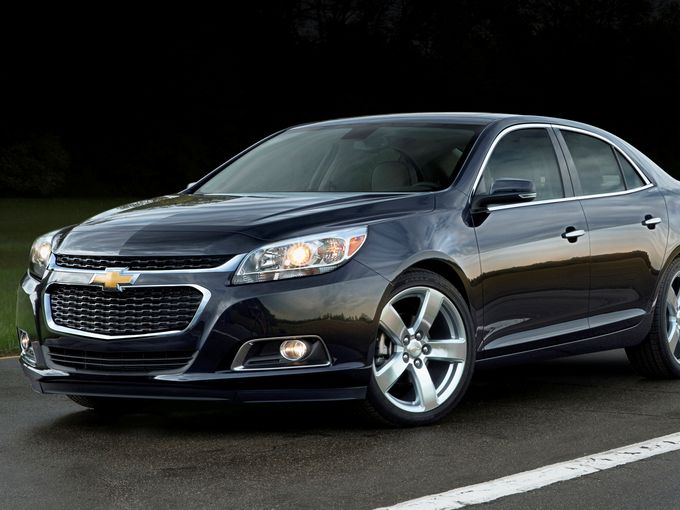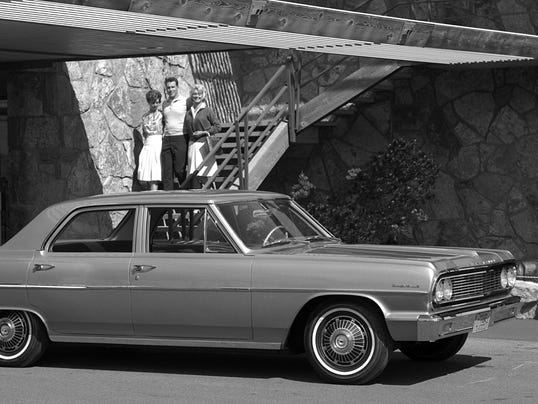Chevrolet Malibu hits age 50
Those sharp creases in the sheet metal of today's Chevrolet Malibu aren't wrinkles -- even though the midsize sedan is marking its 50th birthday.
Back then, Chevrolet was all about its full-size Impala. But today, in a downsized era, Malibu competes in the hottest car segment.
At the time, the 1964 Malibu was considered one of the first "intermediate" cars on sale in the U.S., General Motors says. It was the next size up from the Chevy II, or Nova, not to mention the ill-fated Corvair.
Chevrolet gives this history:
Generation 1 – 1964-1967
Although originally launched as premium sedan for families, the first Malibu was quickly caught up in the muscle car wars of the 1960s and soon after its introduction, the sporty Malibu SS was born. The Chevelle SS took the lead for Chevrolet's muscle cars in 1966 and the Malibu continued as the premium model, tailored for the growing number of suburban customers who sought roominess yet efficiency for their long commutes everyday.
Generation 2 – 1968-1972
Based on the original intermediate platform, the 1968-72 models' dimensions shifted with a slightly shorter 112-inch wheelbase for coupes and convertibles and a longer, 116-inch wheelbase for sedans and wagons. Like the 1964-67 models, each model year in the second generation had distinctive year-over-year styling differences.
Generation 3 – 1973-1977
The 1973 introduction of the third-generation Malibu brought a new frame that retained the previous 112-/116-inch wheelbases, but to accommodate new federal crash standards, the bodies grew about five inches in length and one inch in width. A European-inspired Laguna model briefly dethroned the Malibu from its perch atop the midsize hierarchy.
Generation 4 – 1978-1983
Chevrolet discontinued the Chevelle line after 1977 and the next generation of downsized midsize cars would stick strictly with the Malibu name from 1978 onward. They were a foot shorter and more than 500 pounds lighter, offering V-6 and V-8 engines. There was even a dedicated police car package.
Generation 5 – 1997-2003
After a five-year run with the fourth generation, the sun set on Malibu from 1984 until 1997, when it was reborn as an all-new, front-wheel-drive sedan, offering four- and six-cylinder engines. It was named Motor Trend Car of the Year for 1997.
Generation 6 – 2004-2007
Malibu moved to GM's award-winning global architecture for 2004, offering greater technology, efficiency and performance – including the return of the Malibu SS, which featured a 240-horsepower 3.9-liter V-6. The Malibu range also included the Malibu Maxx five-door extended sedan, which offered greater cargo room and innovations such as the ability of the rear seat to slide seven inches fore and after and reclining rear seat.
Generation 7 – 2008-2012
Riding on an enhanced, longer version of the architecture introduced on the 2004 Malibu, the seventh-generation models introduced greater levels of refinement, performance and efficiency – along with enhanced safety features, including standard head curtain side air bags. It was voted the 2008 North American Car of the Year at the North American International Auto Show in Detroit.
Generation 8 – 2013-2014
Redesigned for 2013, Chevrolet further enhanced Malibu for 2014 with greater efficiency, new connectivity features, comfort enhancements and a new front-end appearance. It offers the segment's first engine with standard stop/start technology and an available 2-liter turbo engine with 259 horsepower that continues a performance legacy established 50 years ago.
References
- ^ Last Slide (rssfeeds.usatoday.com)
- ^ Next Slide (rssfeeds.usatoday.com)





















